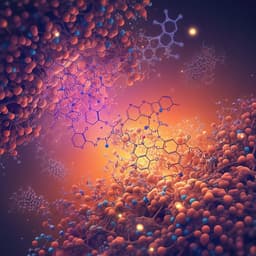
Environmental Studies and Forestry
Understanding the biogeochemical mechanisms of metal removal from acid mine drainage with a subsurface limestone bed at the Motokura Mine, Japan
S. Fuchida, K. Suzuki, et al.
Discover how subsurface limestone beds (SLBs) could revolutionize the removal of toxic metals from acid mine drainage at the Motokura Mine in Japan. This exciting research, conducted by Shigeshi Fuchida, Kohei Suzuki, Tatsuya Kato, Masakazu Kadokura, and Chiharu Tokoro, reveals unique metal precipitation mechanisms that enhance SLB performance through biological agents.
~3 min • Beginner • English
Introduction
Acid mine drainage (AMD) contains hazardous metals (e.g., Mn, Fe, Cu, Zn, As, Cd, Pb). Passive treatment systems (e.g., open limestone channels, limestone leach beds, wetlands, and anoxic limestone drains) can neutralize AMD and remove metals at lower operating costs than active chemical neutralization, but they suffer from issues such as limestone armoring and limited manganese removal. Anoxic limestone drains (ALDs) work best on low-Fe/Al, deoxygenated water and often do not fully remove Mn, Zn, and Cd. Efficient passive treatment requires tailoring to site-specific water chemistry and flow, supported by mechanistic understanding and geochemical modeling. A pilot-scale subsurface limestone bed (SLB) was installed at the Motokura Mine (Hokkaido, Japan) in 2015. This study aims to elucidate the biogeochemical mechanisms and thermodynamics of metal (Mn, Cu, Zn, Cd, Pb) removal within the SLB using field monitoring (2017, 2018), mineralogical/biological analyses, and PHREEQC modeling.
Literature Review
The paper reviews passive AMD treatment technologies: open limestone channels (OLCs) and limestone leach beds (LLBs) are simple and low-cost but can lose effectiveness due to rapid limestone surface coating by Fe/Al precipitates. Wetlands remove metals through biogeochemical processes (vegetation, microbes, organic matter). Subsurface systems like ALDs promote limestone dissolution under anoxic conditions, but their performance declines with elevated Fe, Al, or O₂ due to clogging; guidelines recommend <1 mg/L Fe/Al and low DO. Performance surveys of many ALDs show variable lifetimes and residence times (often 20–100 h), with models sizing ALDs by acidity loading but lacking explicit biochemical reaction consideration. Prior reports indicate Mn, Co, Ni, and Zn often persist after ALDs where pH rises to ~6.5. Consequently, a process-specific, mechanistic understanding—incorporating precipitation, adsorption, microbial oxidation, and calcite dissolution—is necessary to design effective passive systems adapted to local AMD chemistry and flow.
Methodology
Site and systems: The Motokura Mine (Hokkaido, Japan) has been treated since 1982. In 2013 a series of passive units were installed: limestone tank, oxic wetland, and a pilot-scale subsurface limestone bed (SLB). Drainage from multiple tunnels is combined and flows through these units in series. The SLB channel comprises an upper ~40 cm of <40 mm limestone pebbles and a lower 40–120 cm of 40–80 mm limestone gravel; AMD flows through intergranular spaces. Average inflow rates were 131–142 L/min; outflow 60.6–70.8 L/min, indicating ~50% leakage within the SLB.
Field surveys and sampling: Two campaigns were conducted (May 25, 2017; May 29, 2018). Water quality and quantity entering each unit were monitored. Within the SLB, water was sampled from cylinders at points P1–P6 along the flow path (0, 8, 16, 24, 32, 45 m). In situ pH, electrical conductivity (EC), dissolved oxygen (DO), and oxidation-reduction potential (ORP) were measured. Water samples were filtered (0.1 μm mixed cellulose ester) and acid-preserved (1% HNO₃) for cation/anion analyses. Sediment (calcareous gravel) was sampled at 50 cm depth at point B in the SLB and stored frozen in the dark to minimize oxidation and alteration.
Chemical analyses: Dissolved Na, Mg, Ca, Al, Mn, Fe, Cu, Zn, As, Cd, Pb were quantified by ICP-MS (Agilent 7700X). Chloride and sulfate were measured by ion chromatography (Thermo ICS-2100).
Mineralogical analysis (XAFS/XANES): Mn K-edge XAFS was measured at Aichi Synchrotron (BL5S1) and SPring-8 (BL14B2). Freeze-dried sediments were diluted with boron nitride and pelletized (10 mm diameter, 1.0 mm thickness). Spectra (6200–7200 eV) were acquired in transmission with Si(111) monochromator crystals. XANES (6540–6590 eV) was analyzed (Athena software) to determine Mn oxidation state and mineral species using birnessite (δ-MnO₂) and manganite (γ-MnOOH) as references.
Geochemical modeling: PHREEQC v2 was used to simulate 1-D advection with coupled reactions: precipitation, surface complexation, Fe and Mn oxidation, and calcite dissolution. Species, reactions, and equilibrium constants followed prior work; calcite dissolution kinetics after Plummer et al. (1978); Mn oxidation kinetics after Singer & Stumm (1970). The adsorption equilibrium constant for Cd on δ-MnO₂ (MnOH + Cd²⁺ ⇌ MnOCd⁺ + H⁺) was determined experimentally (Log K = 2.9). Model initial compositions used P1 data; flow flux derived from measured flow rate and SLB cross-section. Reactive calcite surface area was fitted separately for upstream (0–24 m) and downstream (25–45 m) reaches to match observed Ca and pH profiles. Output visualization used Microsoft Excel and Adobe Illustrator.
Key Findings
- Along-SLB pH and Ca changes: In both 2017 and 2018, influent pH ~5–6 remained low until ~24 m, then increased to ~8 by 45 m; Ca rose from ~14–16 to 21–29 mg/L, indicating onset of calcite dissolution after ~24 m.
- Metal removal: By the SLB end, Mn, Cu, Zn, Cd, and Pb fell below quantification limits. Cu and Pb removal initiated near pH ~6 (as hydroxides/carbonates), while Zn, Mn, and Cd decreased at pH ~7–8—lower than typical hydroxide precipitation thresholds (Zn ~8; Mn/Cd ~9–10).
- Redox conditions: DO in cylinders remained ~5–9 mg/L; ORP decreased modestly (2017: 396→211 mV; 2018: 331→268 mV), indicating oxygen consumption during reactions but not deoxygenation.
- Mn oxide mineralogy and microbiology: Mn K-edge XANES of SLB sediment showed δ-MnO₂ predominance (>99%), rather than γ-MnOOH expected from slow abiotic oxidation. qPCR detected Mn-oxidizing bacteria (Pseudomonas, Bosea). Literature supports these taxa producing layered Mn oxides akin to δ-MnO₂. Autocatalytic Mn(II) oxidation on δ-MnO₂ surfaces likely further accelerated Mn oxidation.
- Cd removal mechanism: Low Cd/Mn molar ratios in drainage (0.033 in 2017; 0.0049 in 2018) imply Cd removal via surface complexation on δ-MnO₂ rather than surface precipitation. Experimentally determined Log K for Cd adsorption on δ-MnO₂ was 2.9, much higher than for ferrihydrite (0.47), explaining efficient Cd removal at neutral pH.
- Speciation outcomes (model): Zn and >60% of Pb precipitated mainly as hydroxides; Cu and some Pb formed carbonates (malachite Cu₂(OH)₂CO₃; hydrocerrusite Pb(OH)₂(CO₃)₂). Cd removal was dominated by adsorption to δ-MnO₂.
- Model performance and kinetics: PHREEQC simulations matched field pH and metal profiles (2017, 2018). Fitted Mn oxidation rate constants were k₁ = 4.9×10⁻⁷ and k₂ = 2.1×10⁻¹⁰ (units per the cited rate law), indicating microbially enhanced Mn oxidation rates far exceeding abiotic rates.
- Calcite reactivity distribution: Fitted reactive calcite surface areas (m³ L⁻¹): upstream 0–24 m: 0.0008 (2017), 0.0006 (2018); downstream 25–45 m: 0.026 (2017), 0.014 (2018)—a 23–33× higher reactivity downstream. This suggests upstream calcite surfaces were passivated by secondary mineral coatings, reducing neutralization capacity over time.
- Design implications: To meet Japanese effluent standards, a residence time of ~15.5–18.3 h is required for the 670 m³ SLB. Compared with typical ALDs (outflow pH ~6.5), the SLB achieved pH ~8 and removed metals including Mn and Cd, aided by aerobic microbial processes and δ-MnO₂ formation.
Discussion
The study demonstrates that metal removal in the SLB is governed by both geochemical neutralization and biologically mediated processes. Limestone dissolution raises pH sufficiently for Cu, Zn, and Pb to precipitate as hydroxides/carbonates. Crucially, Mn and Cd—often persistent in conventional ALDs—were removed at neutral pH via biologically accelerated Mn(II) oxidation to Mn(IV) and formation of δ-MnO₂, which then served as a high-affinity adsorbent for Cd through surface complexation. The detection of Pseudomonas and Bosea supports a microbial contribution to rapid δ-MnO₂ formation, overcoming slow abiotic Mn oxidation kinetics. Geochemical modeling incorporating precipitation, adsorption, kinetic Mn oxidation, and calcite dissolution reproduced observed profiles and quantified key parameters, including enhanced Mn oxidation rates and spatial variation in limestone reactivity due to passivation. Compared to ALDs, which typically discharge at pH ~6.5 and fail to remove Mn, Zn, and Cd, the SLB achieved pH ~8 and comprehensive metal removal, likely aided by oxic wetland pretreatment supplying nutrients for heterotrophic Mn-oxidizers. However, progressive limestone passivation by secondary minerals reduces neutralization capacity, necessitating maintenance. Overall, coupling microbial Mn oxidation with limestone neutralization is effective for multi-metal AMD treatment and informs sizing (residence time) and maintenance planning.
Conclusion
Field monitoring, mineralogical/biological analyses, and PHREEQC modeling show that the Motokura SLB increases drainage pH from ~5–6 to ~8 between 24 and 45 m via limestone dissolution, precipitating Cu, Zn, and Pb as hydroxides/carbonates. Mn and Cd are removed at pH ~7–8 through biologically facilitated formation of δ-MnO₂ and subsequent Cd adsorption (Log K = 2.9). δ-MnO₂ predominance (>99%) and the presence of Mn-oxidizing bacteria (Pseudomonas, Bosea) confirm the biotic contribution. Modeling indicates required residence times of 15.5–18.3 h for a 670 m³ SLB to meet effluent standards and reveals upstream limestone passivation that diminishes neutralization capacity over time. These mechanistic insights and calibrated models can guide design, sizing, and maintenance of SLBs for AMD with varying chemistry, emphasizing the role of microbial processes to enhance Mn and Cd removal at neutral pH.
Limitations
- Hydraulics: Approximately half the drainage volume leaked through the SLB, introducing uncertainty in actual residence time distribution and contact efficiency.
- DO/ORP measurement artifacts: DO remained high in sampling cylinders and may reflect equilibration with the atmosphere, not strictly in-situ SLB conditions.
- Generalizability: Inflow was oxygenated and preceded by an oxic wetland; results may differ from typical ALDs treating deoxygenated, low-Fe/Al waters. Microbial community composition and density likely vary by site, affecting Mn oxidation rates.
- Passivation and longevity: Progressive limestone passivation was inferred from fitted reactive surface areas, but the rate of neutralization capacity loss was not determined; the SLB had not been dredged since 2013.
- Modeling assumptions: Reactive surface areas and kinetic constants were fitted to field data; parameter values may be site-specific. Units/details for fitted Mn oxidation rate constants depend on the adopted rate law. Periodic dredging/maintenance needs and long-term performance require further study.
Related Publications
Explore these studies to deepen your understanding of the subject.







